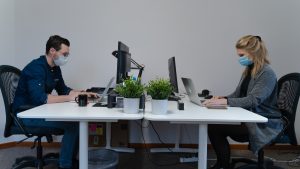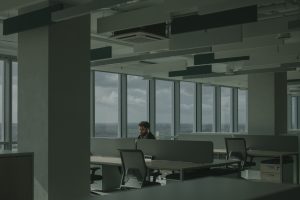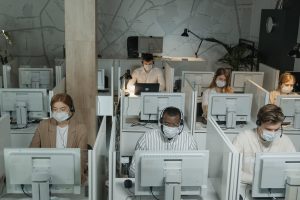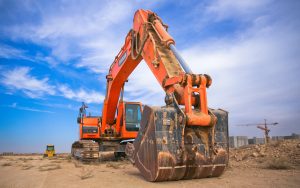Spotlight on COVID safety in the office

Records from Public Health England show that there were more suspected outbreaks in offices during the second half of 2020 than in restaurants, supermarkets, construction sites and warehouses combined. This trend continued into 2021, with over 60 office outbreaks reported in the first two weeks of the latest lockdown.
Although you probably know the basic safety advice off by heart, it’s worth refreshing your memory on some of the finer points. Under the current lockdown rules, all employees should work from home if possible. However, there will be times when coming to the office is unavoidable. For these cases, the government has outlined eight key safety measures:
1. Complete a COVID-19 risk assessment. This should be shared with all staff so that everyone understands their responsibilities.
2. Clean the office regularly, focusing on frequently touched surfaces such as door handles and lift buttons. Provide hand sanitiser for all staff and visitors and encourage frequent hand washing.
3. Ask all visitors to wear face coverings unless they are exempt.
4. Maintain social distancing for all staff and visitors. You can make this easier by rearranging desks, putting up signs and introducing a one-way system.
5. Ensure the building is properly ventilated. You can improve natural ventilation by opening doors and windows, but remember that you need to keep staff warm during the winter. It may be a good idea to relax your company’s dress code so that employees can wear extra layers. Mechanical ventilation systems can also help, but you should avoid those that recirculate air rather than drawing fresh air from outside.
6. Keep an attendance record of all staff and visitors for 21 days. This will allow you to assist the NHS Test and Trace team if necessary.
7. Turn away people with symptoms and send sick employees home. Any visitor or employee with a temperature, persistent cough or loss of taste or smell should be told to self-isolate.
8. Pay attention to mental health. Check in regularly with remote employees and make it clear that anyone who is struggling can come to you for help. The government has published detailed advice on mental health during the pandemic, so be sure to read this and share it with your employees.
What does the Fire Safety Bill mean for workplaces?

Some aspects will apply to commercial premises as well as residential ones. This means that it could have implications for your existing workplace health and safety practices.
Confusingly, a “responsible person” known from fire safety regulation (such as a building owner or an employee given fire safety duties) may have duties which overlap with an “accountable person” as described in the new Buildings Safety Bill which is also being prepared. Under the existing Fire Safety Order, the responsible person is the employer as long as they have some degree of control over the premises. This is likely to remain the case when the new bill comes into effect.
This means that it’s essential to clarify who is responsible for what. It will be more important than ever to put everyone’s duties in writing, and make sure you know where the line is between the “responsible person” and the “accountable person” if both are relevant for your building. If you have any questions, we’re here to help.
Managing the health & safety of lone workers

If you employ roles like cleaners or security staff you will already have some experience with managing lone workers. For many though, this will be uncharted territory. It is therefore important to be aware of the unique dangers of lone working, and to understand your responsibilities towards solitary employees. Although many remote workers are technically lone workers, it’s important not to forget staff who may be unfamiliar with working alone on site.
The HSE categorises lone working as high-risk. Specific lone working risks include accidents, sudden illness and the threat of criminal intruders. There are also psychological dangers to consider such as loneliness and stress. This means that to remain compliant you must take extra precautions.
Start with a full risk assessment. You can adapt your existing risk assessments to fit the profile of lone working. This assessment should outline all potential risks and the ways to mitigate them. If you need help producing it, ask us.
One way of protecting lone workers from physical harm is by providing staff with monitoring devices or personal alarms. If you choose to do this, it is important to clarify who is responsible for maintaining and monitoring these devices.
In terms of mental well-being, regular check-ins may be a good way to combat feelings of loneliness. You should also make it clear that lone workers can approach you if they are struggling.
One in eight employees are going into work unnecessarily

It is important to be sure that nobody is coming into the office unnecessarily. The HSE are continuing to conduct phone interviews and inspections, and will notice if a workplace seems overcrowded. Between 6 and 14 January alone, the HSE received 8,427 COVID-related complaints, 81 of which led to enforcement action.
The best place to start is with your existing COVID risk assessments. These should allow you to weigh up the safest place for each employee to work. In many cases, this will be from home. If you’re unsure, don’t hesitate to get in touch.
Mythbusters

A few years back a major civil engineering contractor insisted that all routine heavy lifting operations had to be directly supervised. This meant that an additional member of staff had to be present whenever anyone was using a lorry loader crane. When put to the HSE myth buster panel, they decided that this was unnecessary as long as the lift operator was properly trained. Unusually complex or dangerous lifting may require additional supervision, but the contractor must be able to justify their decision.
In a separate case, a building site operator told employees that they couldn’t wear shorts, insisting that they wear plastic waterproof trousers instead. It is true that certain tasks will require building site employees to wear PPE. For example, working with wet cement can cause skin irritation if legs are left uncovered. However, most of the time, shorts are completely acceptable. Not that we imagine many workers will be showing up in shorts during this February freeze.

